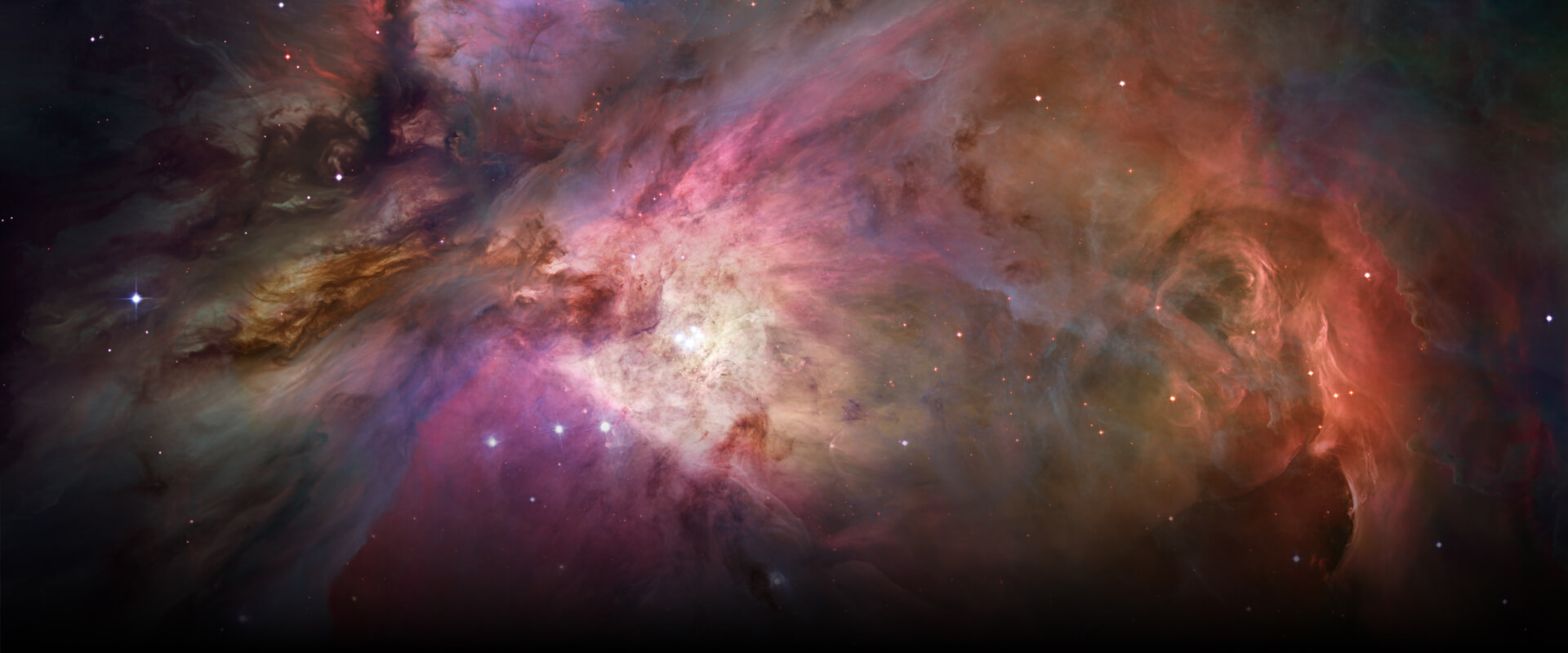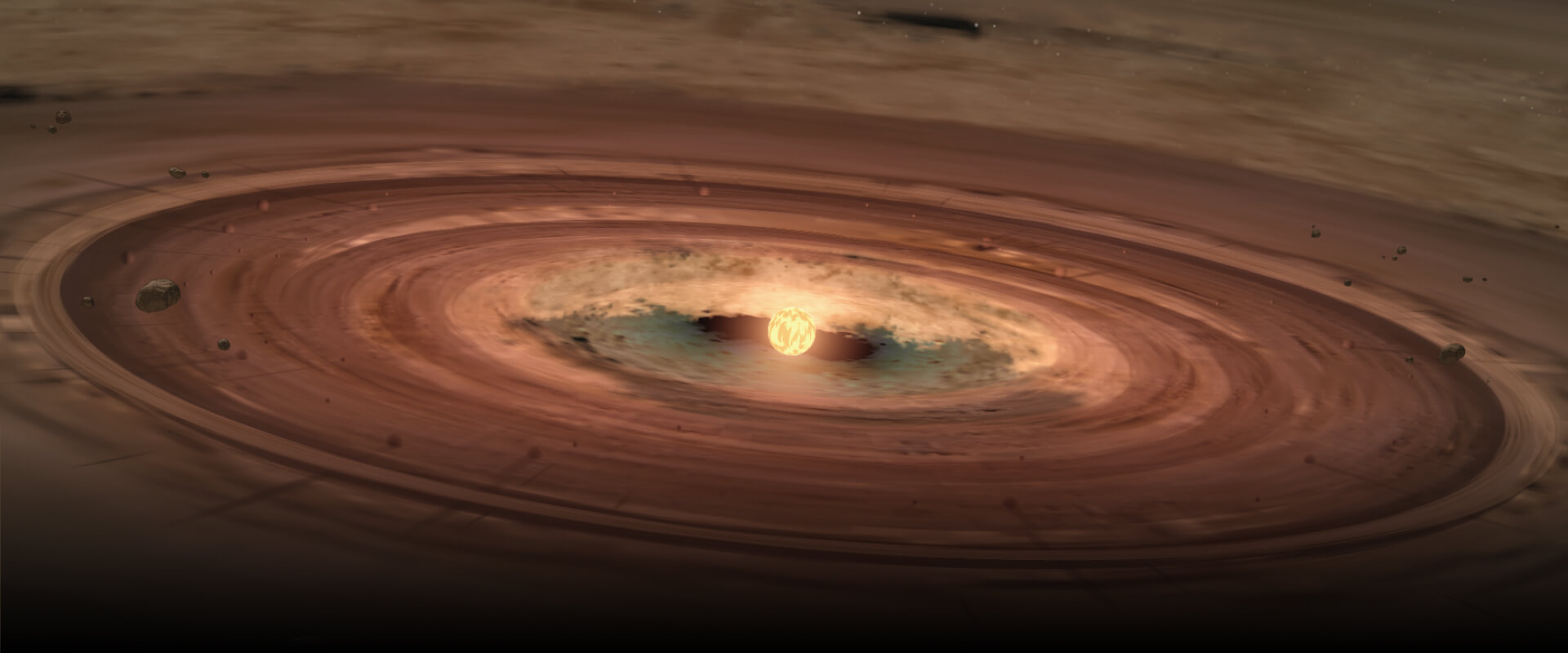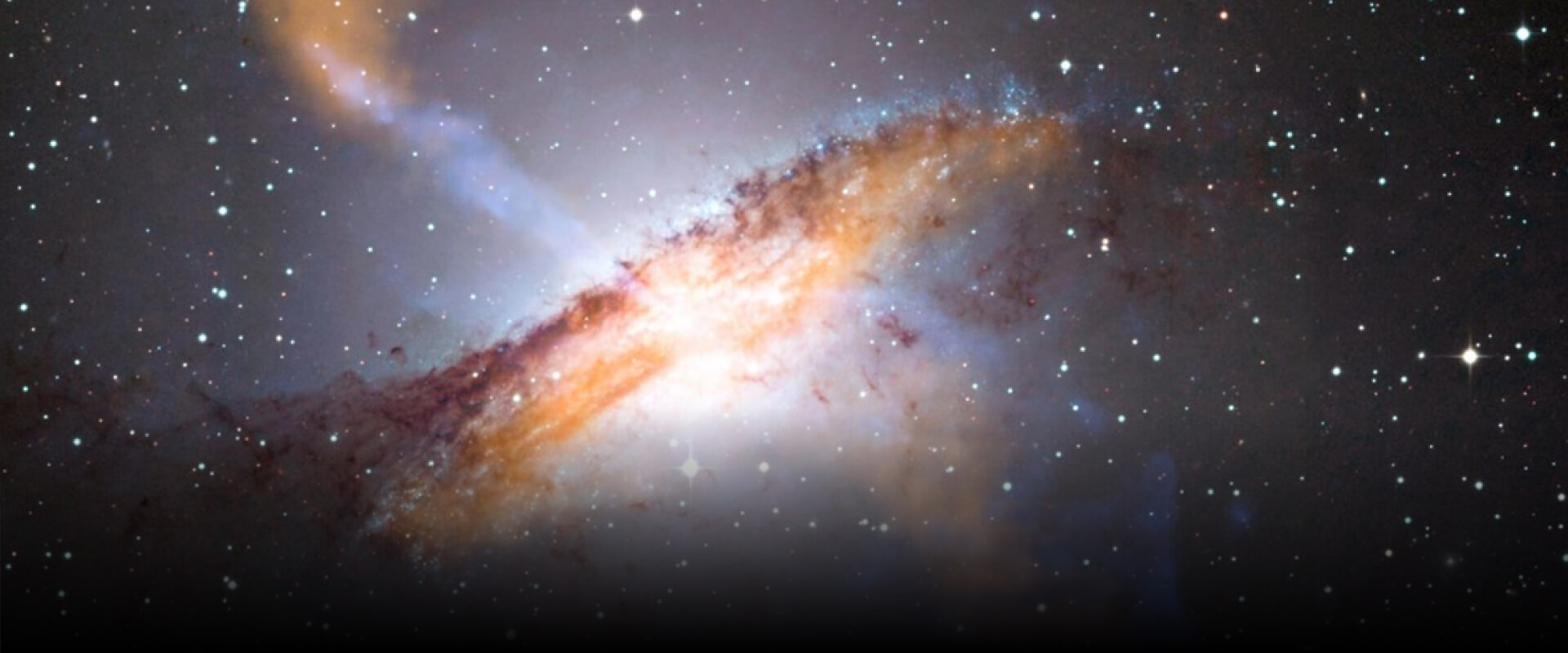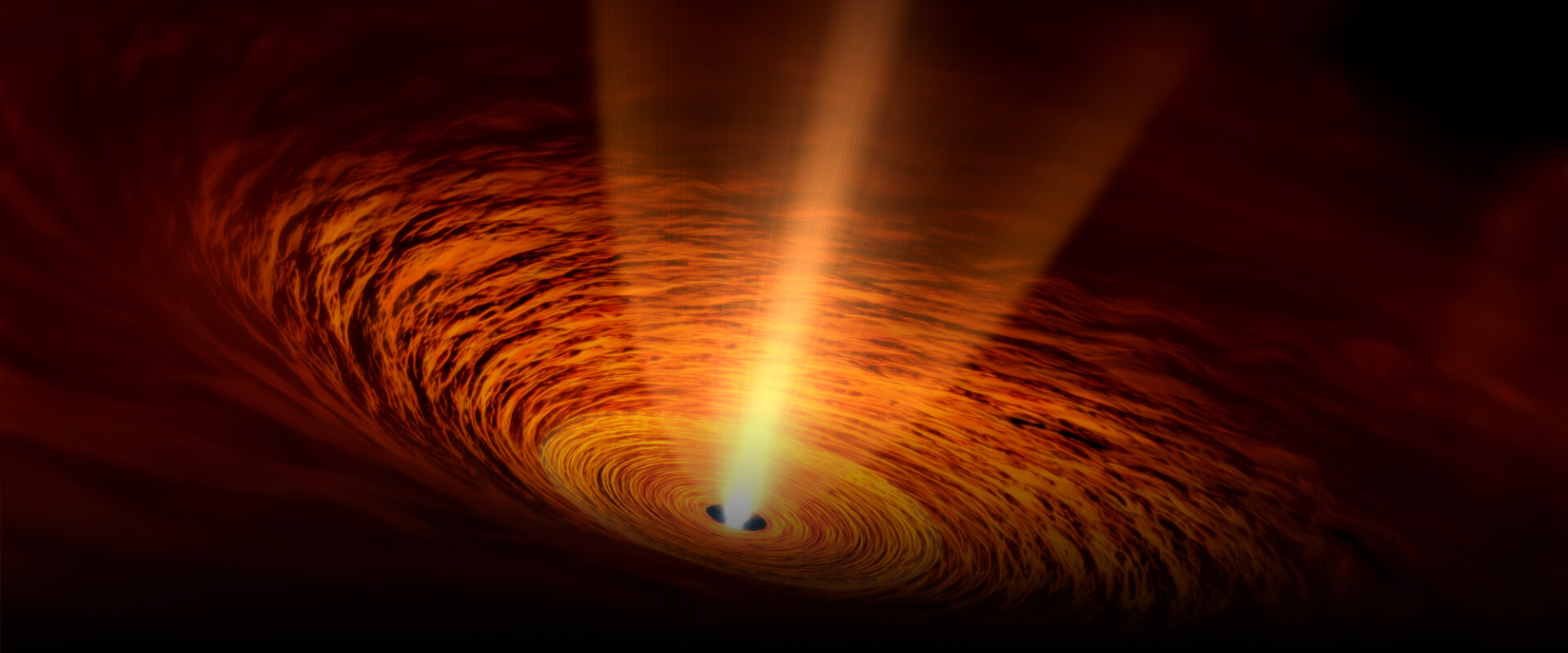Division of Science, NAOJ
Observations with the James Webb Space Telescope (JWST) have revealed a population of objects in the early universe that exhibit extremely broad hydrogen emission lines (Hα) with velocity widths exceeding 1,000 km/s. Many of these sources are extremely compact and red, known as “Little Red Dots” (LRDs)—a class of objects virtually unseen in the nearby universe.
Because such high-velocity Hα emission is a hallmark of radiation originating from gas rapidly orbiting an accreting supermassive black hole in the central regions of galaxies — that is, an active galactic nucleus (AGN) — these discoveries have been widely interpreted as evidence that the early universe contained far more AGNs than previously expected, implying the rapid growth of supermassive black holes at early cosmic times. However, decisive observational proof that these objects truly host AGNs has been lacking.
A research team led by Dr. Mitsuru Kokubo (NAOJ Fellow, National Astronomical Observatory of Japan) and Dr. Yuichi Harikane (Assistant Professor, Institute for Cosmic Ray Research, The University of Tokyo) set out to test the AGN hypothesis directly. By combining multi-epoch JWST/NIRCam imaging with extremely deep Chandra X-ray observations, they searched for key observational signatures that must be present if these sources indeed harbor AGNs. Specifically, AGNs typically show rapid ultraviolet–optical variability originating from the accretion disk, as well as strong X-ray emission from the innermost disk regions.
Surprisingly, the analysis revealed no detectable variability in the rest-UV to optical wavelengths for any of the five broad-Hα objects studied. Moreover, none of the sources showed the X-ray emission that is universally observed in standard AGNs.
These results indicate that the observed objects differ fundamentally from ordinary AGNs. Their properties cannot be explained by conventional AGN models, suggesting that alternative physical mechanisms may be responsible. The authors propose several non-AGN scenarios, including high-velocity gas flows generated by intense star formation, or radiative transfer effects in which stellar ultraviolet light is scattered by surrounding hydrogen gas, producing an apparent high-velocity Hα component.
The findings imply that our current understanding of the relationship between supermassive black hole growth and galaxy evolution in the early universe—and the prevalence of AGNs at high redshift—may need to be significantly revised. Future work, including more detailed spectroscopy, multi-wavelength follow-up observations, and improved theoretical modeling, will be crucial for uncovering the true nature of these enigmatic early-universe objects.
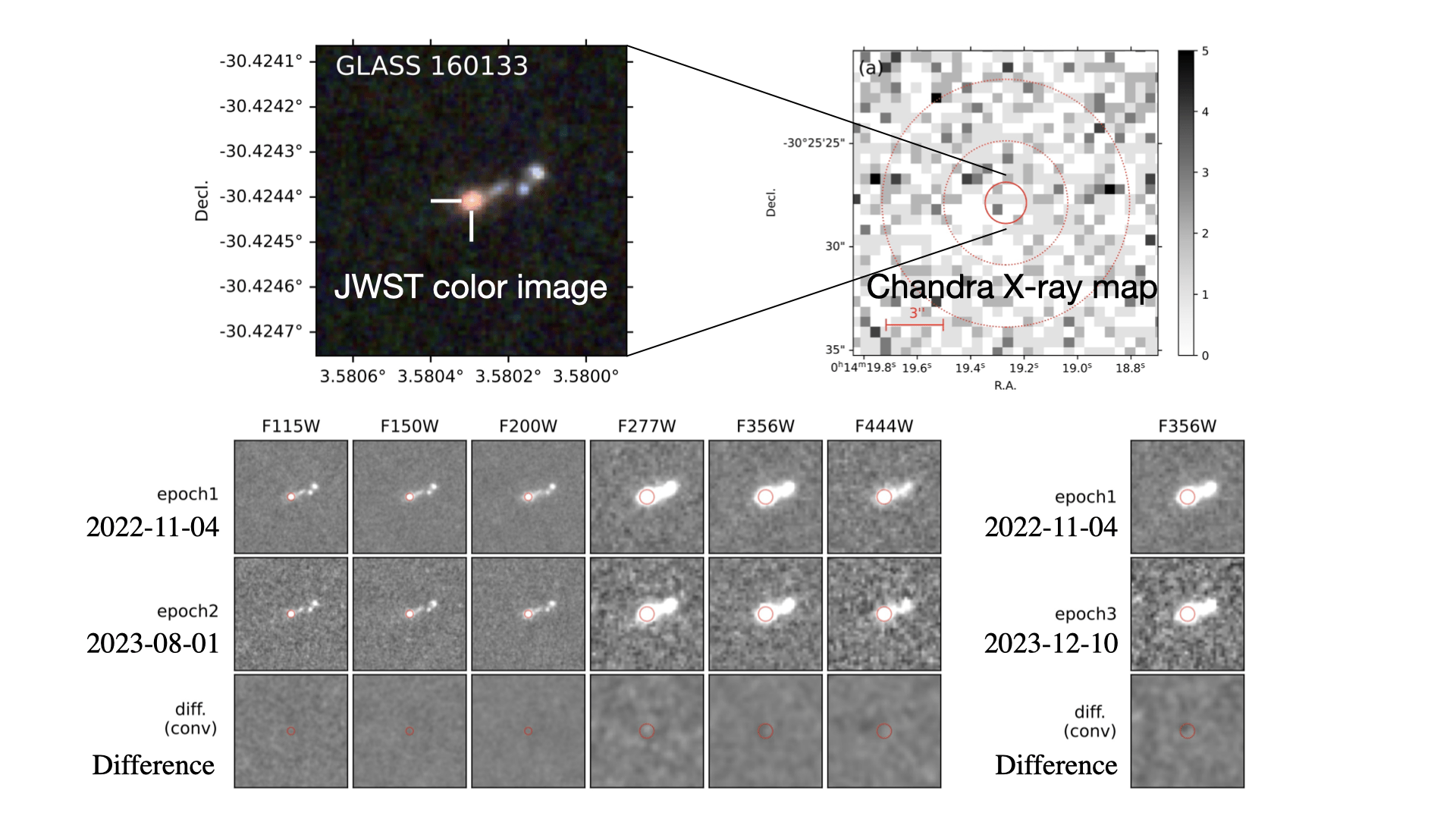
Paper Information
Title: Challenging the Active Galactic Nucleus Scenario for JWST/NIRSpec Little Red Dot and Non-Little Red Dot Broad Hα Emitters in Light of Nondetection of NIRCam Photometric Variability and X-Ray
Authors: Mitsuru Kokubo, Yuichi Harikane
Journal: The Astrophysical Journal
DOI: 10.3847/1538-4357/ae119e
URL: https://iopscience.iop.org/article/10.3847/1538-4357/ae119e
How were our Solar System and exoplanets formed? Research to date has shown that planets are born within so-called protoplanetary disks – structures of gas and dust surrounding young stars. However, the detailed processes that lead to planet formation remain shrouded in mystery.
One feature that has long been thought to play an important role in planet formation is the spiral structure that can emerge within protoplanetary disks due to the self-gravity. Within these spirals, solid particles may efficiently collide and grow, eventually reaching planetary sizes. In some cases, the spirals themselves may directly fragment to planets. On the otherhand, it is also known that spiral structures can be created by massive planets that have already formed. This means that the presence of spirals alone does not allow researchers to determine whether planets are on the verge of forming or have already been born.
An international research team led by Tomohiro Yoshida, a graduate student at the National Astronomical Observatory of Japan (NAOJ) and the Graduate University for Advanced Studies (SOKENDAI), focused on a theoretical prediction that these two scenarios could be distinguished by the motion of the spirals. If the spirals are produced by the self-gravity of the disk prior to planet formation, they are expected to wind and eventually dissipate. In contrast, if the spirals are induced by an already-formed planet, they should retain their shape and co-rotate with the planet.
The team investigated the protoplanetary disk surrounding the young star IM Lupus, which exhibits prominent spiral arms. By combining images obtained with the Atacama Large Millimeter/submillimeter Array (ALMA) over four observation periods in 2017, 2019, and 2024, spanning seven years, the researchers created a “movie” of the disk. The results revealed dynamic winding motions of the spirals. This finding indicates that the spirals are caused by the self-gravity of the disk. Such spirals are believed to promote planet formation, suggesting that this disk is caught in the very moment before planets are born.
These results were published as Tomohiro C. Yoshida et al., “Winding Motion of Spirals in a Gravitationally Unstable Protoplanetary Disk” in Nature Astronomy on September 24, 2025.
https://www.nature.com/articles/s41550-025-02639-y
Press release from NAOJ/ALMA project:
https://alma-telescope.jp/en/news/press/vimage-202509.html
Using high-resolution observations from ALMA (Atacama Large Millimeter/submillimeter Array) and JWST (James Webb Space Telescope), we have unveiled the intricate details of star formation in the nearby high-density cluster-forming region Oph A. The most striking discovery is seven planetary-mass objects. Three of them are associated with near-infrared point sources, suggesting they are extremely young free-floating planets or brown dwarfs (Fig1). The remaining four are dense cores without infrared emission, likely to evolve into free-floating planets or brown dwarfs in the future (Fig2). Remarkably, these dense cores appear connected to finger-like structures extending from the triple protostar system VLA1623-2417 (central-lower panel of Fig2), hinting that these planetary-mass objects may have been ejected from the protostellar system—offering new insights into their formation and ejection mechanisms. Additionally, a combined analysis of ALMA and JWST images revealed previously unseen features, including new protostellar outflows and jets, striped patterns on HII region shells likely generated by MHD waves, and warm gas flows from HII regions, shedding light on complex structures that had remained hidden until now.
Article Information
Fumitaka Nakamura , Ryohei Kawabe , Shuo Huang , Kazuya Saigo , Naomi Hirano , Shigehisa Takakuwa , Takeshi Kamazaki , Motohide Tamura , James Di Francesco , Rachel Friesen , Kazunari Iwasaki , and Chihomi Hara:
“Unveiling Stellar Feedback and Cloud Structure in the Rho Ophiuchi A Region with ALMA and JWST: Discovery of Substellar Cores, C18O Striations, and Protostellar Outflows”
(To be published in The Astrophysical Journal)
https://arxiv.org/abs/2509.01122
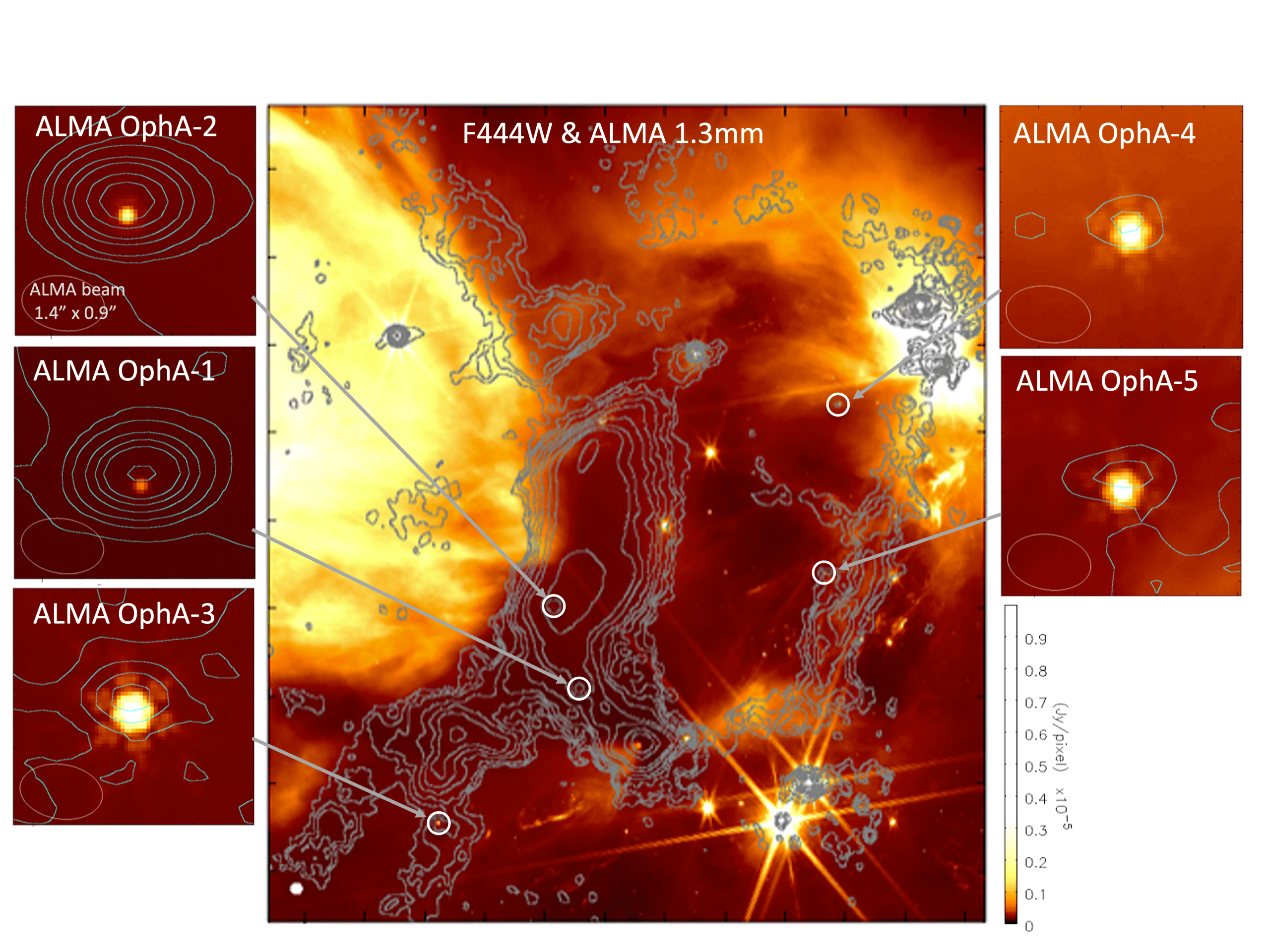
Estimated masses: ~10 Jupiter masses each.
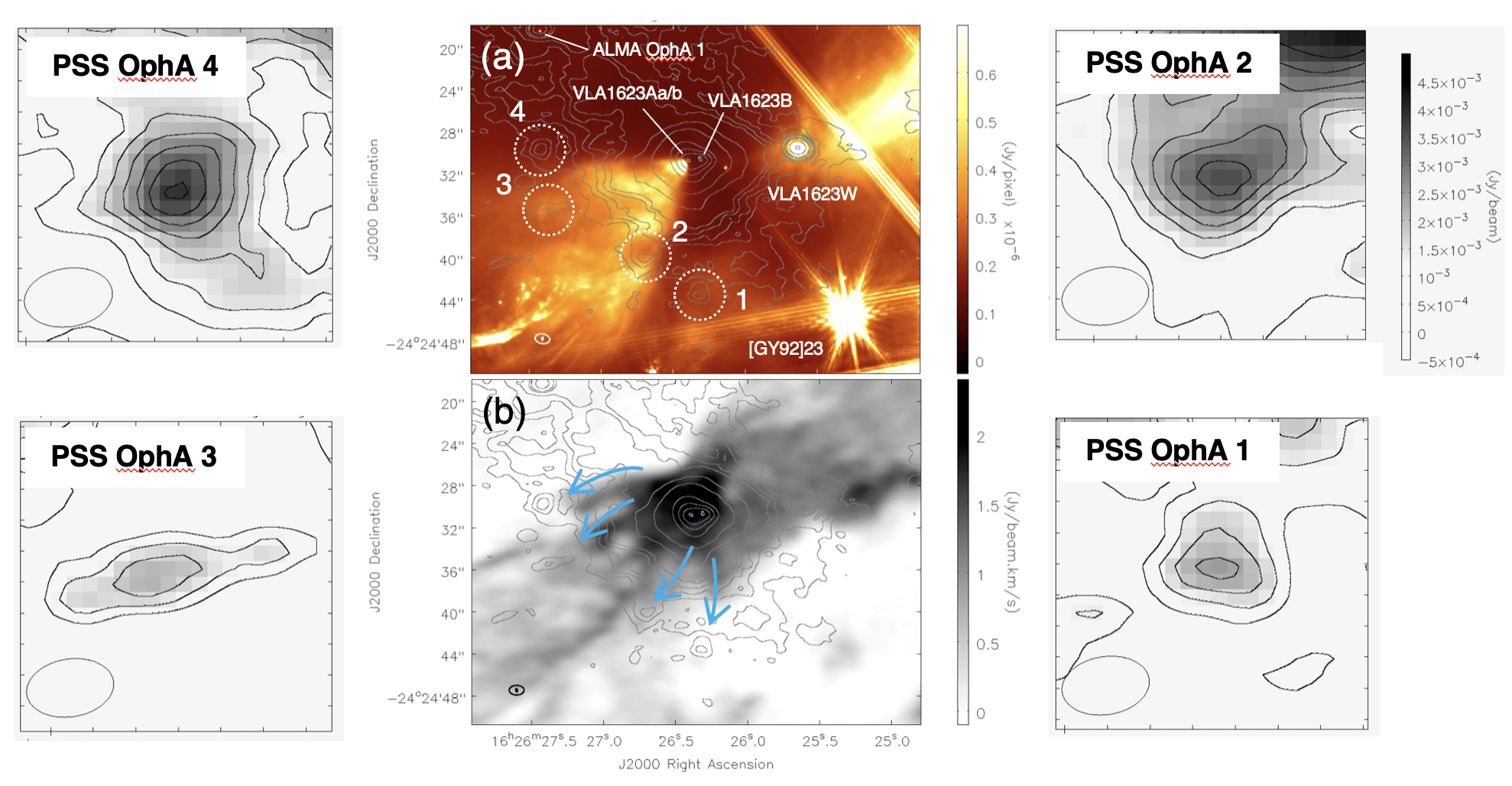
Estimated masses: several tens of Jupiter masses.
For decades, formation of high-mass stars exceeding 8 solar masses has remained one of astronomy’s greatest mysteries. In a recent study published in Astronomy & Astrophysics, a global team of astronomers, including researchers from Yunnan University, Shanghai Astronomical Observatory and Division of Science of NAOJ, has carried out cutting-edge observations toward a “hub-filament system” (HFS) molecular cloud—a cradle of high-mass star formation, and has uncovered stunning new evidence that challenges current theories and illuminates the multi-scale, dynamical nature of high-mass stellar birth.

Using the world’s most advanced (sub)millimeter interferometer, ALMA, the research team conducted ~3000AU resolution observations at the 1.3mm wavelength toward the HFS I18308 cloud, a high star-forming region with a textbook example of HFS morphologies (left panel, Figure 1). The team revealed dual fragmentation modes. Two hub-composing filaments (F1 and F2) exhibit a cylinder-like fragmentation mode, with the quasi-periodic core spacings regulated by the turbulence-dominated fragmentation mechanism. In contrast, the central hub clump shows a spherical-like fragmentation mode, with the core spacings regulated by gravity-dominated Jeans fragmentation mechanism. These findings challenge models predicting a single fragmentation mode across all density scales within molecular clouds (e.g., the global gravitational collapse model).
Moreover, the team did not find high-mass prestellar cores surpassing 30 solar masses; and instead all relatively low-mass cores show a systematic increase in mass and density with evolution. These observed facts support a multi-scale accretion scenario: low-mass prestellar cores form via Jeans fragmentation in the hub, collapse into intermediate-mass protostars, and grow into high-mass stars through hierarchical mass accretion from the filaments, hub clump, and cores (right panel, Figure 1).
Article Information
L. M. Zhen, H-L. Liu, X. Lu, Y. Cheng, R. Galván-Madrid, H. B. Liu, P. Sanhueza, T. Liu, D. T. Yang, F. Nakamura, S. H. Jiao, L. Chen, Y. Q. Guo, S. Y. Feng, Q. Zhang, X. C. Liu, K. Wang, Q. L. Gu, Q. Y. Luo, Y. Lin, P. S. Li, S. H. Li, K. Tanaka , A. E. Guzmán, “Hierarchical fragmentation in HFS I18308 observed as part of the INFANT survey”, Astronomy & Astrophysics, 2025, 70, A47.
https://doi.org/10.1051/0004-6361/202554634
Corresponding Authors: Y. Cheng, H-L. Liu, X. Lu
Authors: Takashi Hamana (NAOJ), Chiaki Hikage (Kavil IPMU), Masamune Oguri (Chiba University), Masato Shirasaki (NAOJ & The Institute of Statistical Mathematics), Surhud More (The Inter-University Center for Astronomy and Astrophysics)
Overview:
Cosmic shear is the coherent distortion of the shapes of distant galaxies caused by gravitational lensing of intervening large-scale structures, and is one of the most powerful tools for cosmology.
We perform a cosmic shear analysis of Hyper Supreme-Cam Subaru Strategic Program first-year data (HSC-Y1) to derive cosmological constraints. For an estimator of cosmic shear signals, we adopt orthogonal sets of E/B-integrals (COSEBIs) which allows us to separate the cosmic shear signals into independent E/B-modes.
We measure cosmic shear E/B-mode COSEBIs from shapes of ~10 million distant galaxies with good signal-to-noise ratios (Figure-1). We find that the B-mode signals are consistent with zero, which is consistent with the prediction of the standard gravity theory.
We perform a standard Bayesian likelihood analysis for cosmological inference from the measured E-mode COSEBIs, in which we adopt a covariance matrix derived from realistic mock catalogs constructed from full-sky gravitational lensing simulations done using the super-computer system XC30 at CfCA, NAOJ. We obtain constraints on cosmological parameters, the total matter density parameter and the amplitude parameter of the density fluctuation at present universe (Figure-2). It is found that our results are consistent with results of the CMB experiment by Planck mission, supporting the standard cold-dark matter universe model with the cosmological constant.

Figure-1: Comparison of the HSC-Y1 tomographic cosmic shear COSEBIs with the best-fitting theoretical model for the cold-dark matter model with the cosmological constant. Left and right triangular-tiled panels show E and B-mode cosmic shear COSEBIs, respectively. Error bars represent the square-root of the diagonal elements of the covariance matrix. The solid lines in the top panels correspond to the best-fitting (maximum likelihood) model.
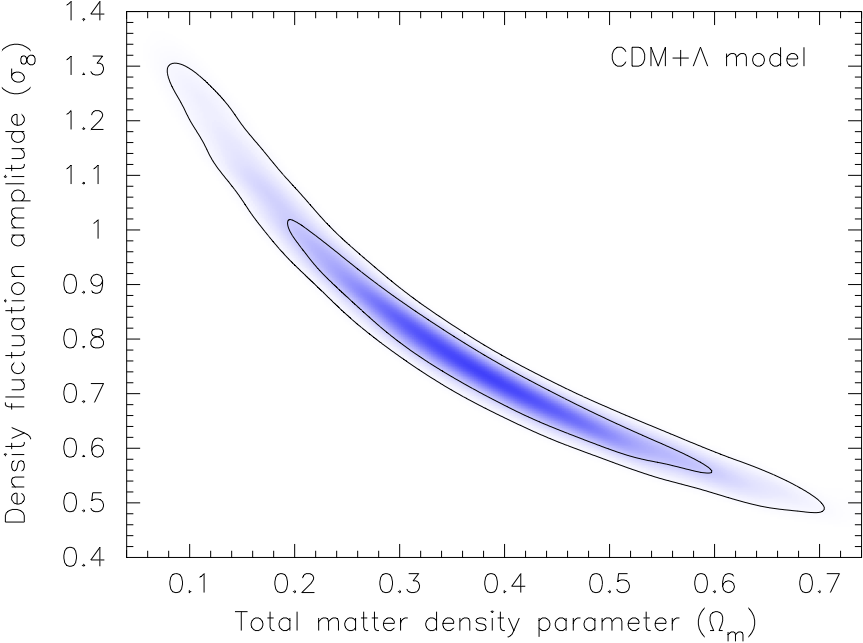
Figure-2: Marginalized posterior contours (68% and 95% confidence levels) with a blue scale for a visual overview of the distribution (darker for higher posterior) in the plane of the total matter density parameter (horizontal axis) and the amplitude parameter of the density fluctuation at present universe (vertical axis).
See the URLs below for the details.
Link to the paper (PASJ web page): https://academic.oup.com/pasj/article-abstract/74/4/923/6610012
Hyper Suprime-Cam Subaru Strategic Program: https://hsc.mtk.nao.ac.jp/ssp/
Center for Computational Astrophysics (CfCA): https://www.cfca.nao.ac.jp/
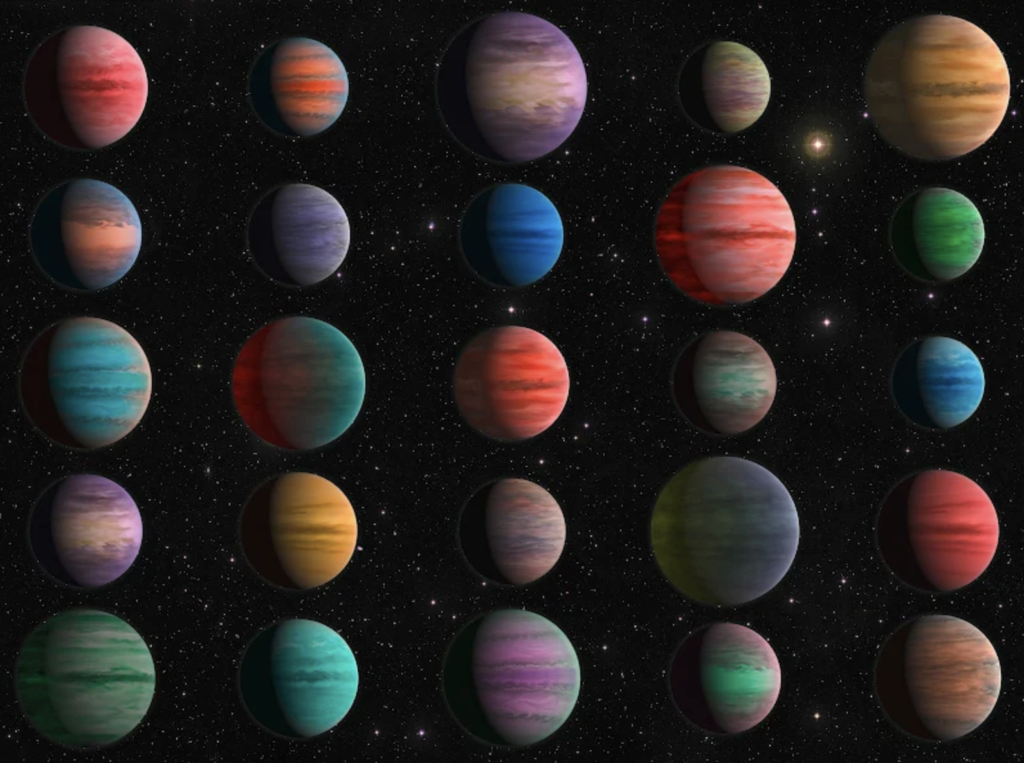
The research field of exoplanets has entered an era in which we not only detect new planets but also investigate (characterize) in detail the properties of already detected planets. An international research team that Prof. Masahiro Ikoma of the Division of Science, NAOJ, joins has developed and applied a new analysis method (atmospheric retrieval method) to infrared spectroscopic data for 25 hot Jupiters obtained by the secondary eclipse observation method with the Hubble Space Telescope and Spitzer Space Telescope. The team has succeeded in extracting some correlations between their atmospheric properties including the temperature structure and chemical compositions, which had not been known before. This research has led to a new phase from the characterization of “individual” planets to that of planetary “populations.” The findings obtained in this study will be further investigated and verified by the James Web Space Telescope (JWST) which was launched last year and the Atmospheric Remote-sensing Infrared Exoplanet Large-survey (Ariel), which is scheduled for launch in 2029. The characterization of planetary populations developed in this study will also be useful and crucial to understanding the characteristics, formation, and evolution of various types of planets.
So far, about 5,000 exoplanets have been discovered. However, no planetary system with a structure like that of our Solar System has been found among them, indicating that planetary systems are indeed diverse. In particular, gas giant planets called “hot Jupiters,” which orbit close to their host stars, do not exist in our Solar System, and their characteristics and formation remain a mystery. To characterize the atmospheres of the 25 hot Jupiters, the research team reanalyzed a vast amount of archived data consisting of approximately 600 hours of Hubble Space Telescope observations and more than 400 hours of Spitzer Space Telescope observations. They found that secondary eclipses (see Figure 2) were observed for all the 25 hot Jupiters, which occur when an exoplanet passes behind the central star as seen from the Earth, and the apparent decrease in the central star’s luminosity is called a “secondary eclipse. By spectroscopically observing the apparent decrease in the luminosity of the central star, we can estimate the vertical distribution of the atmospheric composition and temperature of the planet.
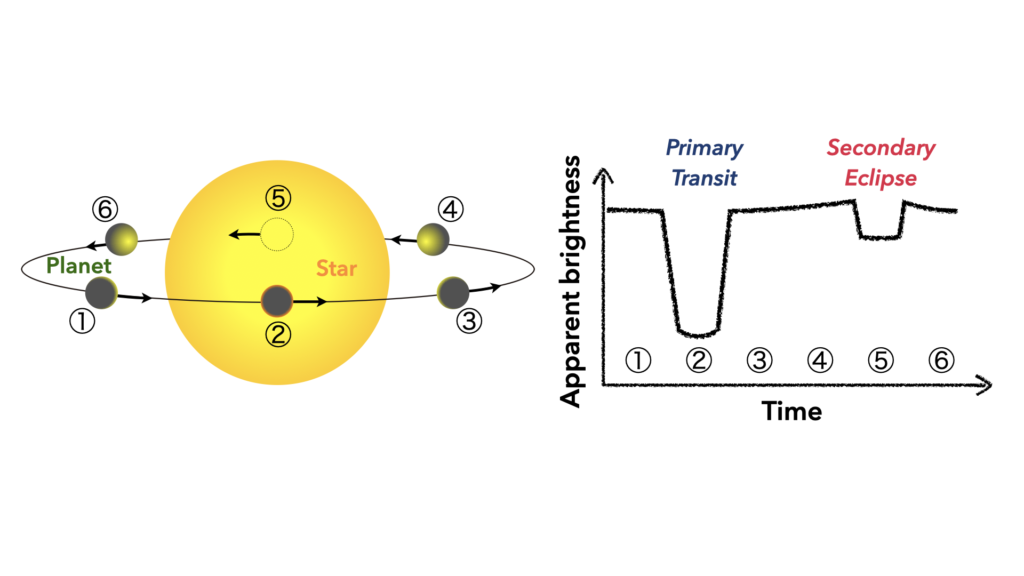
As a result of these systematic characterizations of many hot Jupiters, the research team found several clear trends and correlations among the hot Jupiter properties. For example, they found that in more than half of the atmospheres in their sample, the temperature increases with altitude (so-called temperature inversion). And those atmospheres were found to contain titanium oxide (TiO), vanadium oxide (VO), iron hydride (FeH), or hydrogen negative ions (H-) at temperatures higher than 2000 K. From this fact, one can infer that planetary atmospheres being hot enough to contain such metallic species absorb large amounts of central stellar light and heat the upper atmosphere, resulting in a temperature inversion. For the relatively cooler atmospheres, the team found that there are two populations, one in which H2O is detected and the other in which no H2O is detected. For the latter population, it was suggested that H2O is not chemically produced because of the relatively high carbon content of the atmosphere. In addition, such population study has led to validating or disproving what had previously been suggested by the characterization of individual planets.
This research is presented in the following paper published on April 25, 2022, in the Astrophysical Journal Supplement Series: Changeat et al. “Five key exoplanet questions answered via an analysis of 25 hot Jupiter atmospheres in eclipse”
The Astrophysical Journal Supplement Series : https://iopscience.iop.org/article/10.3847/1538-4365/ac5cc2
YouTube : Hubble Helps Answer Key Exoplanet Questions
A research group led by National Astronomical Observatory of Japan, Institute of Astronomy and Astrophysics, Academia Sinica (ASIAA), and Osaka Prefecture University has developed a new ultra-wideband, high-sensitivity eQ receiver which is capable of observing from 30 to 50 GHz (a wavelength of about 7mm). It was successfully installed on the NRO 45m radio telescope and detected SiO maser line from the late-type star, RR Aql (see Fig. 1). Fumitaka Nakamura, Ryohei Kawabe, and Kotomi Taniguchi from our Division of Science participated in the installation campaign. Chau-Ching Chiong, who is in charge of the receiver development at ASIAA, also participated via zoom from Taiwan. Recently, ALMA started installation of Band-1 receivers with similar band (33-50 GHz). The eQ receiver has the widest bandwidth and highest sensitivity in the similar frequency range. In addition, this is the first time that a receiver developed overseas has been mounted on the 45m telescope.
We will mainly promote the following three sciences: (1) Zeeman measurements with SO/CCS lines, (2) detection of line emission from high-z galaxies, and (3) astrochemistry in 30-50GHz, and will prepare for upcoming ALMA Band-1 observations.
Figure 1: the eQ frist light with a SiO maser line from RR Aql.
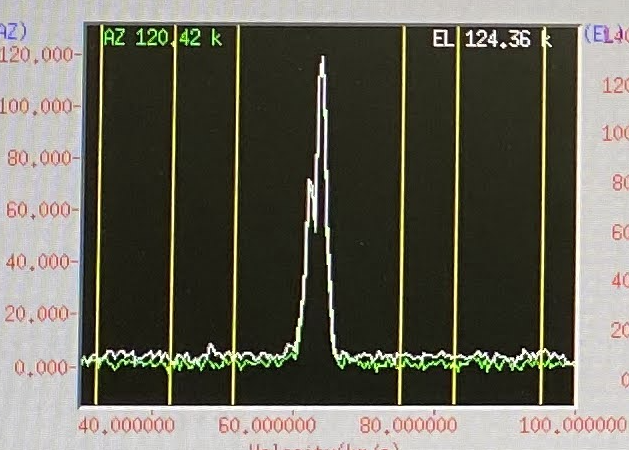
Figure 2: the eQ receiver and our installation team

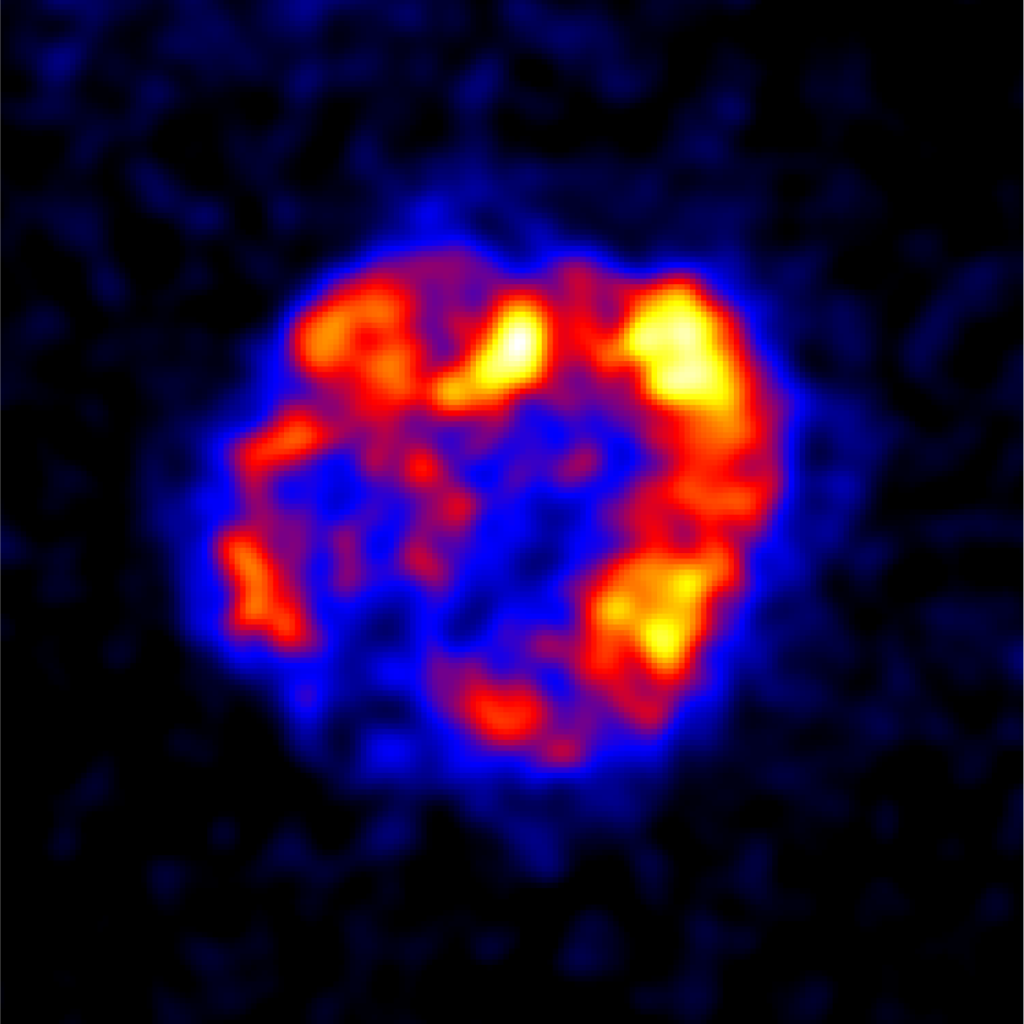
An international research team including Dr. Hidetoshi Sano has succeeded for the first time in quantifying the proton and electron components of cosmic rays in a supernova remnant. At least 70% of the very-high-energy gamma rays emitted from cosmic rays are due to relativistic protons, according to the novel imaging analysis of radio, X-ray, and gamma-ray radiation. The acceleration site of protons, the main components of cosmic rays, has been a 100-year mystery in modern astrophysics, this is the first time that the amount of cosmic rays being produced in a supernova remnant has been quantitatively shown and is an epoch-making step in the elucidation of the origin of cosmic rays.
The origin of cosmic rays, the particles with the highest energy in the universe, has been a great mystery since their discovery in 1912. Because cosmic rays promote the chemical evolution of interstellar matter, understanding their origin is critical in understanding the evolution of our Galaxy. The cosmic rays are thought to be accelerated by supernova remnants (the after-effects of supernova explostions) in our Galaxy and traveled to the Earth at almost the speed of light. Recent progress in gamma-ray observations has revealed that many supernova remnants emit gamma-rays at teraelectronvolts (TeV) energies. If gamma rays are produced by protons, which are the main component of cosmic rays, then the supernova remnant origin of cosmic rays can be verified. However, gamma rays are also produced by electrons, it is necessary to determine whether the proton or electron origin is dominant, and to measure the ratio of the two contributions. The results of this study provide compelling evidence of gamma rays originating from the proton component, which is the main component of cosmic rays, and clarify that Galactic cosmic rays are produced by supernova remnants.
The originality of this research is that gamma-ray radiation is represented by a linear combination of proton and electron components. Astronomers knew a relation that the intensity of gamma-ray from protons is proportional to the interstellar gas density obtained by radio-line imaging observations. On the other hand, gamma-rays from electrons are also expected to be proportional to X-ray intensity from electrons. Therefore, they expressed the total gamma-ray intensity as the sum of two gamma-ray components, one from the proton origin and the other from the electron origin. This led to a unified understanding of three independent observables. This method was first proposed in this study. As a result, it was shown that gamma rays from protons and electrons account for 70% and 30% of the total gamma-rays, respectively. This is the first time that the two origins have been quantified. The results also demonstrate that gamma rays from protons are dominated in interstellar gas-rich regions, whereas gamma rays from electrons are enhanced in the gas-poor region. This confirms that the two mechanisms work together and supporting the predictions of previous theoretical studies.
This research was presented in the following paper on July 9, 2021, in the Astrophysical Journal.
Fukui, Sano, Yamane et al. “Pursuing the Origin of the Gamma Rays in RX J1713.7−3946 Quantifying the Hadronic and Leptonic Components”, ApJ, 915, 84 (2021)
DOI: https://doi.org/10.3847/1538-4357/abff4a
See the URL below for the details.
Nagoya University: https://en.nagoya-u.ac.jp/research/activities/news/2021/08/post-2.html
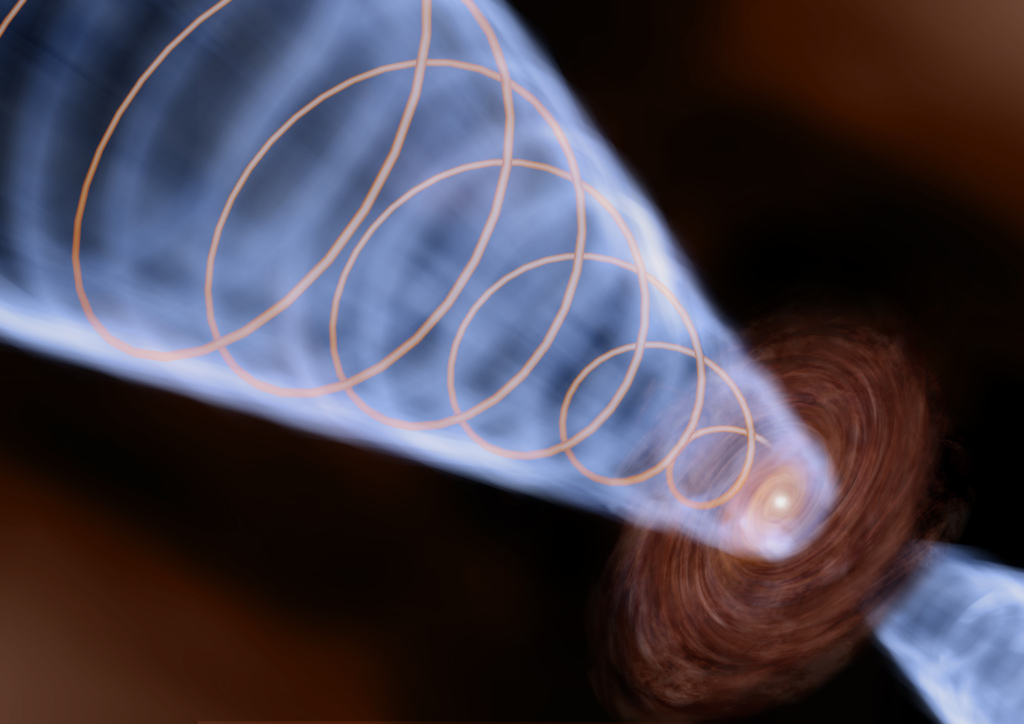
Dr Yuko Matsushita released her research results.
See the URL below for the details.
ALMA – NAOJ: https://alma-telescope.jp/en/news/jetrotation-202108
Kyushu University: https://www.kyushu-u.ac.jp/ja/researches/view/625
The Astrophysical Journal: https://iopscience.iop.org/article/10.3847/1538-4357/ac069f/meta
Authors: Kangrou Guo, Eiichiro Kokubo
Standard models of planet formation explains how planets form in axisymmetric, unperturbed disks in single star systems. However, it is possible that giant planets could have already formed when other planetary embryos start to grow. We investigate the dynamics of planetesimals under the perturbation of a giant planet in a gaseous disk. Our aim is to understand the effect of the planet’s perturbation on the formation of giant planet cores outside the orbit of the planet. We calculate the orbital evolution of planetesimals ranging from 10^13 to 10^20 g, with a Jupiter-mass planet located at 5.2 au. We find orbital alignment of planetesimals distributed in about 9-15 au, except for the mean motion resonance (MMR) locations. The degree of alignment increases with increasing distance from the planet and decreasing planetesimal mass. When the orbits of two objects are aligned, they encounter on tangential trajectories with low relative velocities, which lead to a higher chance of accumulation. The typical velocity dispersion for identical-mass planetesimals is of the order 10 m s^−1, except for the MMR locations. The relative velocity decreases with increasing distance from the planet and decreasing mass ratio of planetesimals. When the eccentricity vectors of planetesimals reach equilibrium under the gas drag and secular perturbation, the relative velocity becomes lower when the masses of two planetesimals are both on the larger end of the mass spectrum. Our results show that with a giant planet embedded in the disk, the growth of another planetary core outside the planet orbit might be accelerated in certain locations.
Link to the paper (arXiv): https://arxiv.org/abs/2106.06240

Figure 1: Schematic illustration of alignment of orbits. The dashed curves indicate parts of the orbits that are below the reference plane (yellow). (a): non-aligned orbits, m1 and m2 encounter with high relative velocity. (b): aligned orbits, m1 and m2 encounter on almost tangential orbits and with low relative velocity. This figure shows that even when two particles are on eccentric and inclined orbits, they can encounter with a low relative velocity when their orbits are well-aligned.

Figure 9 (b): Color maps of relative velocities at about 0.5 million years near 12 au. The relative velocity increases with increasing mass ratio. The typical relative velocity of identical-mass particles is on the order of 10 m/s.

Figure 10: Comparison of growth timescales in the aligned case (yellow) and non-aligned case (red) at different orbital distances. When the orbits are aligned, the growth timescale is significantly shorter – the growth of another planetary core outside the giant planet perturber can be accelerated under the coupling effect of secular perturbation and nebula gas drag.
Contact: Kangrou Guo (carol.kwok@grad.nao.ac.jp)
